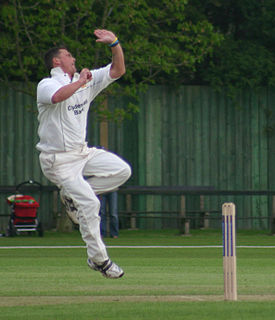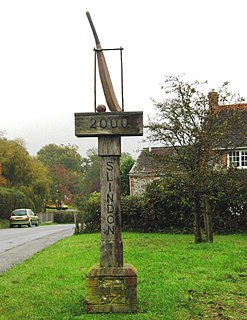Related Research Articles

Bowling, in cricket, is the action of propelling the ball toward the wicket defended by a batter. A player skilled at bowling is called a bowler; a bowler who is also a competent batter is known as an all-rounder. Bowling the ball is distinguished from throwing the ball by a strictly specified biomechanical definition, which restricts the angle of extension of the elbow. A single act of bowling the ball towards the batsman is called a ball or a delivery. Bowlers bowl deliveries in sets of six, called an over. Once a bowler has bowled an over, a teammate will bowl an over from the other end of the pitch. The Laws of Cricket govern how a ball must be bowled. If a ball is bowled illegally, an umpire will rule it a no-ball. If a ball is bowled too wide of the striker for the batsman to be able to play at it with a proper cricket shot, the bowler's end umpire will rule it a wide.
Underarm bowling is a style of bowling in cricket. The style is as old as the sport itself. Until the introduction of the roundarm style in the first half of the 19th century, bowling was performed in the same way as in the sport of bowls, with the ball being delivered with the hand below the waist. Bowls may well be an older game than cricket and it is possible that it provided a template for delivering a ball with a degree of accuracy.
The Laws of Cricket is a code which specifies the rules of the game of cricket worldwide. The earliest known code was drafted in 1744 and, since 1788, it has been owned and maintained by its custodian, the Marylebone Cricket Club (MCC) in London. There are currently 42 Laws which outline all aspects of how the game is to be played. MCC has re-coded the Laws six times, the seventh and latest code being released in October 2017. The 2nd edition of the 2017 Code came into force on 1 April 2019. The first six codes prior to 2017 were all subject to interim revisions and so exist in more than one version.

This is a general glossary of the terminology used in the sport of cricket. Where words in a sentence are also defined elsewhere in this article, they appear in italics. Certain aspects of cricket terminology are explained in more detail in cricket statistics and the naming of fielding positions is explained at fielding (cricket).

In cricket, a no-ball is a type of illegal delivery to a batter. It is also a type of extra, being the run awarded to the batting team as a consequence of the illegal delivery. For most cricket games, especially amateur, the definition of all forms of no-ball is from the MCC Laws of Cricket.

A delivery or ball in cricket is a single action of bowling a cricket ball toward the batsman. Once the ball has been delivered, batsmen may attempt to score runs, with the bowler and other fielders attempting to stop this by getting the batsmen out. When the ball becomes dead, the next delivery can begin.
John Small was an English professional cricketer who played during the 18th century and had one of the longest careers on record. Born at Empshott, Hampshire, he is generally regarded as the greatest batsman of the 18th century and acknowledged as having been the first to master the use of the modern straight bat which was introduced in the 1760s. He probably scored the earliest known century in important cricket. He died at Petersfield, where he was in residence for most of his life and where he established businesses.
Richard Nyren was an English professional cricketer who played first-class cricket during the heyday of the Hambledon Club. A genuine all-rounder and the earliest known left-hander of note, Nyren was the captain of Hampshire when its team included players like John Small, Thomas Brett and Tom Sueter. Although the records of many matches in which he almost certainly played have been lost, he made 51 known appearances between 1764 and 1784. He was known as the team's "general" on the field and, for a time, acted as the club secretary as well as taking care of matchday catering for many years.
In cricket, roundarm bowling is a bowling style that was introduced in the first quarter of the 19th century and largely superseded underarm bowling by the 1830s. Using a roundarm action, the bowlers extend their arm about 90 degrees from their body at the point where they release the ball. Roundarm fell into decline after 1864 when the current style of overarm bowling was legalised, although W. G. Grace continued to use it to the end of his career.
Thomas Walker was an English cricketer who played for Hampshire in the days of the Hambledon Club and later for Surrey. He was famous for his brilliant defensive batting. He is also credited with introducing, roundarm bowling, the predecessor of modern overarm bowling.
Thomas Waymark was an English professional cricketer in the first half of the 18th century. He is one of the earliest known players on record and is widely accounted the sport's first great all-rounder.

In cricket, overarm bowling refers to a delivery in which the bowler's hand is above shoulder height.

Richard Newland (1713–1778) was an English cricketer of the mid-Georgian period who played for Slindon and Sussex under the patronage of Charles Lennox, 2nd Duke of Richmond. He also represented various England teams and, in some matches, led his own select team. The eldest of three cricketing brothers, he is generally recognised as one of cricket's greatest early players and has been called a pioneer of the sport.

David Harris was an English cricketer who played first-class cricket from 1782 to 1798.
Lamborn was a significant English cricketer who played for the Hambledon Club in the 18th century and is recognised as one of the greatest innovators in the history of bowling.
John Frame was an English cricketer of the mid-Georgian period who played for Dartford, Kent and Surrey. He also represented various England teams. He was born in Warlingham, Surrey, and died in Dartford, Kent. His known career spanned the 1749 to 1774 English cricket seasons from the ages of 16 to 41.

Edward Aburrow Sr (c.1715–?), also known as Cuddy, was an English cricketer of the mid-Georgian period who played for Slindon and Sussex under the patronage of Charles Lennox, 2nd Duke of Richmond. He also represented various England teams. He was born in Slindon, Sussex, and was a contemporary of the three Newland brothers. Outside of cricket, Aburrow Sr was a tailor in Slindon but he became involved in smuggling and was jailed in 1745, though he turned King's evidence to gain parole. He relocated to Hambledon, Hampshire and his son Edward Aburrow Jr, also known as "Curry", became a regular Hambledon player.
The Cricketers of My Time is a memoir of cricket, nominally written by the former Hambledon cricketer John Nyren about the players of the late 18th century, most of whom he knew personally. Nyren, who had no recognised literary skill, collaborated with the eminent Shakespearean scholar Charles Cowden Clarke to produce his work. It is believed that Cowden Clarke recorded Nyren's verbal reminiscences and so "ghosted" the text.
On 11 and 12 February 1851, teams from Van Diemen's Land and Port Phillip District played the first cricket match between two Australian colonies, recognised in later years as the inaugural first-class cricket match in Australia. It took place at the Launceston Racecourse, known now as the NTCA Ground, in Tasmania. The match was incorporated into celebrations marking the separation of the Port Phillip District from New South Wales in 1851 as the colony of Victoria.
The period from 1776 to 1800 saw significant growth and development in English cricket to the point that it became a popular sport nationwide, having outgrown its origin in the south-eastern counties. Prominent northern clubs were established at Nottingham and Sheffield. The earliest known references have been found for cricket in Canada (1785) and the West Indies. In India, British clubs were founded at Calcutta (1792) and, following the siege there, Seringapatam (1799). In America, the game was popular among soldiers in the revolution and George Washington is known to have played in at least one game.
References
- ↑ Nyren 1998, pp. 153–154.
- 1 2 3 4 Bowen, Rowland (1965). "Cricket in the 17th and 18th centuries". Wisden Cricketers' Almanack. Retrieved 24 October 2022.
- ↑ Haygarth 1862, p. 18.
- ↑ "At the Sign of the Wicket", F. S. Ashley-Cooper, Cricket, issue 531, 25 January 1900, p. 4.
- ↑ The painting is Francis Hayman's Cricket at the Artillery Ground (1743). It hangs in the Lord's pavilion.
- ↑ Ashley-Cooper 1924, p. 17.
- ↑ Ashley-Cooper 1924, p. 20.
- ↑ Ashley-Cooper 1924, pp. 18–19.